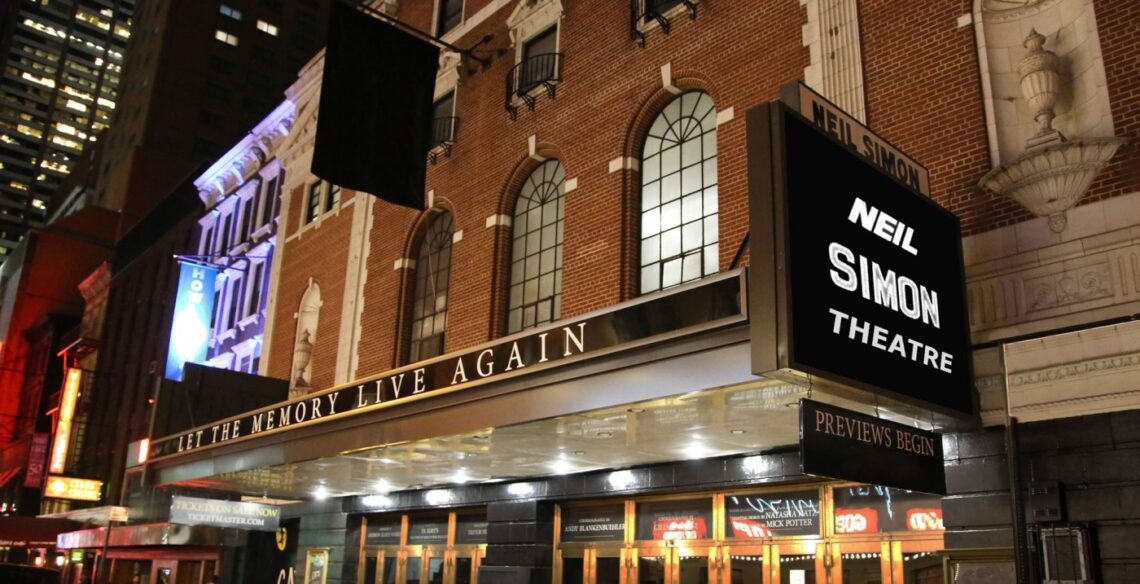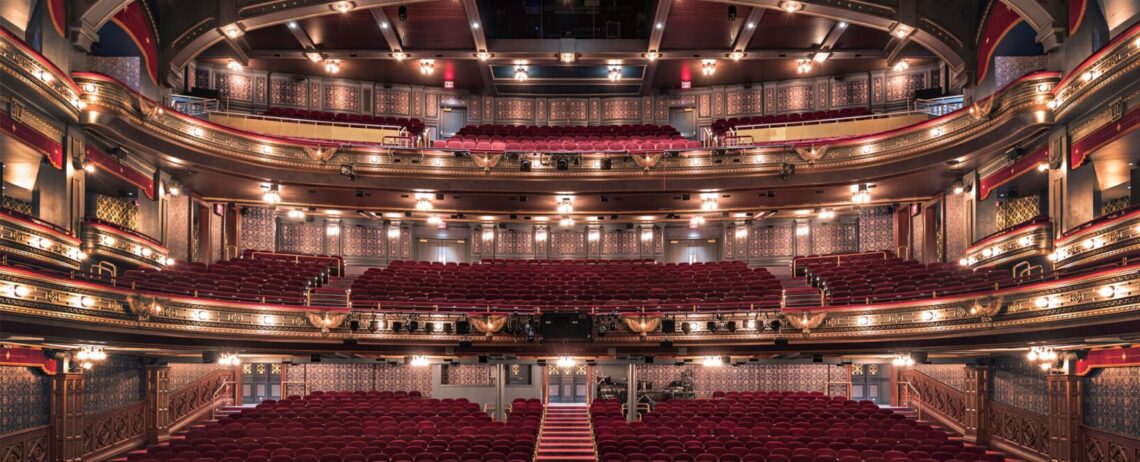-
Radio City Music Hall
1260 6th Ave, New York, NY 10020 – – The Music Hall opened to the public on December 27, 1932, with a lavish stage show featuring numbers including Ray Bolger, Doc Rockwell, Martha Graham, The Mirthquakers, and Patricia Bowman. The opening was meant to be a return to high-class variety entertainment. However, the opening was not a success: the program was very long, spanning from 8 p.m. to 2 a.m. of the next day, and a multitude of acts were crammed onto the world’s largest stage, ensuring that individual acts were lost in the cavernous hall. As the premiere went on, audience members, including John Rockefeller Jr, waited in the…
-
Neil Simon Theatre
250 W 52ND ST, NEW YORK, NY 10019 – – The facade is divided into two sections: the six-story stage house to the west and the five-story auditorium to the east. The ground floor is clad with terracotta blocks and contains an entrance with a marquee. The upper stories of both sections are made of brick and terracotta; the auditorium facade has arched windows, niches, and a central pediment, while the stage house is plainer in design. The interior is designed in the Adam style and includes two lobbies and a mezzanine-level lounge. The auditorium consists of a ground-level orchestra and one balcony with boxes. The theater interiors are decorated…
-
Music Box Theatre
239 W 45th St, New York, NY 10036 – – The facade is made of limestone and is symmetrically arranged, with both Palladian and neo-Georgian motifs. At ground level, the eastern portion of the facade contains the theater’s entrance, with a marquee over it, while the stage door is to the west. A double-height central colonnade at the second and third floors conceals a fire-escape staircase; it is flanked by windows in the outer bays. The auditorium contains Adam style detailing, a large balcony, and two outwardly curved box seats within ornate archways. The theater was also designed with a comparatively small lobby, a lounge in the basement, and mezzanine-level…
-
Palace Theatre
1564 Broadway, New York, NY 10036 – – The Palace was most successful as a vaudeville house in the 1910s and 1920s. Under RKO Theatres, it became a cinema in the 1930s, though it continued to host intermittent vaudeville shows in the 1950s. The Nederlander Organization purchased the Palace in 1965 and reopened the venue as a Broadway theater the next year. The theater closed for an extensive renovation from 1987 to 1991, when the original building was demolished and replaced with the DoubleTree Suites Times Square Hotel. The DoubleTree Hotel was itself demolished in 2019 to make way for the TSX Broadway development. The Palace closed again in 2018 and is being lifted 30…
-
New Amsterdam Theatre
214 W 42nd St, New York, NY 10036 – – On October 26, 1903, the opening of the New Amsterdam Theatre was a highly anticipated New York City event. Designers Henry Herts and Hugh Tallent set out to build the most spectacular theatre in New York. They were so confident in their endeavor that they designed the theatre’s interior specifically for her inaugural production of A Midsummer Night’s Dream. The following morning’s review in The New York Times spoke little of the play, but hailed the New Amsterdam Theatre as “The House Beautiful,” a nickname that still holds true today. Over 113 years later, the New Amsterdam is the oldest…
-
NYC Luxury Stretch Limousine Tour
Forget subways and overwhelming guidebooks — take a chauffeured journey by limousine around Lower Manhattan on this private 3 or 5 hour tour. Enjoy personalized attention from your native New Yorker guide and get an eye-opening look into historic neighborhoods, listen to in-the-know commentary and capture marvelous city views. Travel in style as you hit the top attractions. The more you discover, the more you’ll want to see: Consider an upgrade to a 5-hour tour to include Upper and Mid-Manhattan, the perfect way to get to know New York in a day.
-
Belasco Theater
111 W 44th St, New York, NY – – David Belasco opened the Stuyvesant in October 1907, having already bequeathed his name on his 42nd St playhouse, now the New Victory. When he relinquished the 42nd St theatre in 1910, he immediately renamed the Stuyvesant as the Belasco. He provided himself with a duplex apartment above the theatre that had the décor of a Gothic church, and housed much of his theatrical memorabilia. Following his death, the theatre was rumored to be haunted by his ghost, until it was banished by the risqué production, Oh Calcutta!. The theatre came under Shubert ownership in 1948. Belasco conceived the auditorium of the Belasco…
-
The Shubert Theatre
225 W 44th St, New York, NY 10036 – – The Shubert’s facade is made of brick and terracotta, with sgraffito decorations designed in stucco. Three arches face south onto 44th Street, and a curved corner faces east toward Broadway. To the east, the Shubert Alley facade includes doors to the lobby and the stage house. The auditorium contains an orchestra level, two balconies, and a flat ceiling. The space is decorated with mythological murals throughout. Near the front of the auditorium, flanking the elliptical proscenium arch, are box seats at balcony level. The upper levels contain offices formerly occupied by the Shubert brothers, and the stage house to the north is shared with the Booth Theatre. The Shubert is part of the largest…
-
Lyric Theatre
214 West 43rd Street; Manhattan, New York City; United State – – The original Lyric, managed by the Shubert Brothers, opened on October 12, 1903 with Old Heidelberg starring Richard Mansfield. Most of its successes were musical. Two major composers of operetta had hits there: Oscar Straus, whose most famous show, The Chocolate Soldier (based on Shaw’s Arms and the Man), opened at the Lyric in 1909 to run for 296 performances, and Rudolf Friml, whose first show, The Firefly, opened at the Lyric in 1912. Friml’s last hit, The Three Musketeers, produced by the fabled Florenz Ziegfeld, played there for seven months in 1928 (an impressive run in those days). The glory years of the Lyric,…
-
Winter Garden Theatre
1634 BROADWAY, NEW YORK, NY 10019 – – Shubert has owned the Winter Garden Theatre longer than any of its other venues. The playhouse occupies the second American Horse Exchange, built by William K. Vanderbilt in 1896, when Longacre (now Times Square) was the center of the horse and carriage trade. By 1911, when the Shuberts leased the Exchange, horses had given way to the automobile and legitimate stage was making inroads north of 42nd St. The Winter Garden was converted into a theatre in 1911, and had brief interludes as a movie house from 1928 to 1933 when Warner Brothers leased it, and again in 1945, when United Artists…












